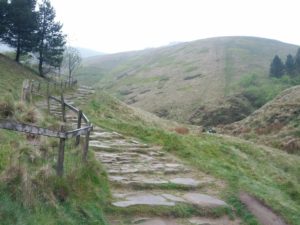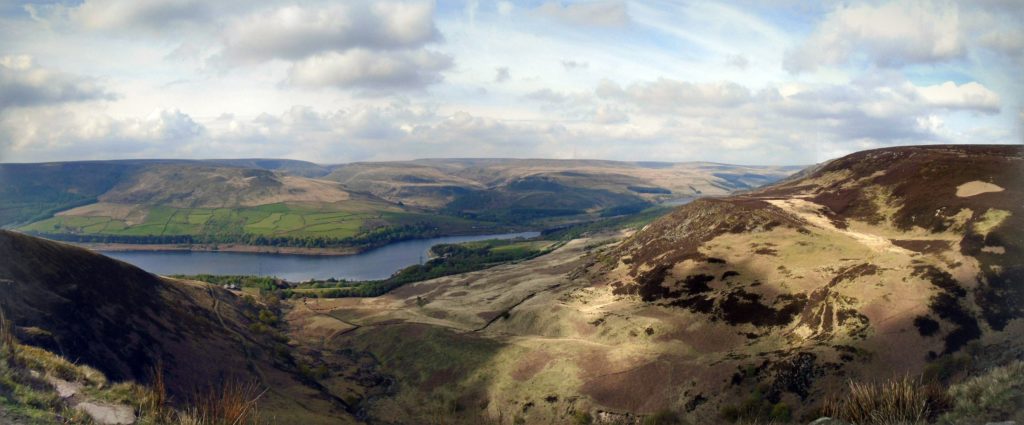One of the big surprises of walking the Pennine way was seeing how much space there is in England. As great as the South Downs National Park is, you’re never far from roads and pubs: it’s a thin strip through a densely populated region. Further north, particularly in the Cheviots, there is little visible sign of humanity other than the path itself and maybe a nearby fence.
Everywhere, those fences. Sometimes there are also signs saying who owns the land. Tramping through the countryside, you understand that the paths are ways through other people’s property, that these spaces belong to particular people.
 The first section of the Pennine Way, just after Jacob’s Ladder, passes close to Kinder Scout, the highest point in the Peak District. Back in 1932 it was the site of what Roy Hattersley described as “the most successful act of direct action in British history“.
The first section of the Pennine Way, just after Jacob’s Ladder, passes close to Kinder Scout, the highest point in the Peak District. Back in 1932 it was the site of what Roy Hattersley described as “the most successful act of direct action in British history“.
Back then, there was no right to walk across this area of the country. But, on April 24th 1932, a group of about 400 walkers was following the path when a whistle sounded. They stopped and turned to face up the hill. Another whistle. And, on the third sound of the whistle, they left the path and began to climb towards the Peak of Kinder Scout. Between them and the hilltop were a line of gate-keepers, some of them armed with sticks, who were ready to fight to prevent the trespass.
The group contained both committed ramblers and newcomers, who’d been invited by flyers, which promised: “Come with us for the best day out that you ever had”. The walkers were in high spirits that day, joining in songs such as It’s a Long Way to Tipperary. Among the organisers were a communist organisation, and the walk included some spirited renditions of The Red Flag.
The moor owners and gamekeepers were determined to keep ramblers off the Pennines. The area of land wasn’t farmed, but rather reserved for shooting on a few days each August. Despite this, there was no right to access these areas. The mass trespass didn’t reach the top of the hill, and there was some hand-to-hand fighting, in which a gamekeeper was injured. The police arrested five or six people who were soon put on trial. The arrests were for the violence rather than the trespass, which was not a criminal offence.
At his trial, the ringleader, Benny Rothman, delivered a prepared speech.
We ramblers, after a hard week’s work [living] in smoky towns and cities, go out rambling on weekends for relaxation, for a breath of fresh air, and for a little sunshine. And we find, when we go out, that the finest rambling country is closed to us. Because certain individuals wish to shoot for about ten days per annum, we are forced to walk on muddy, crowded paths, and denied the pleasure of enjoying, to the utmost, the countryside. Our request, or demand, for access to all peaks and uncultivated moorland is nothing unreasonable.
Rothman was sentenced to four months, but had began a process that led to the National Parks act and the establishment of the National Trails. That was a long process, however. Some groups resisted these changes, such as The British Waterworks Association, which opposed the 1939 access to mountains bill because of “the tendency of such areas (ie mountains and moorlands) to become a resort for undesirable characters among whom immorality and licentiousness is rife”
In his book Watling Street, John Higgs points out that of the UK’s 52 million acres, a third is owned by 1200 aristocrats and families. Much of this is transferred through trusts without tax, allowing land to be stockpiled – only 100,00 acres comes on to the market each year. There is no cost to owning this and keeping it out of the hands of others. Higgs quotes Lloyd George: “Who made 10,000 people owners of the land and the rest of us trespassers in the land of our birth?”
